|
Participate in the Great Bee Count Sat. July 16
|
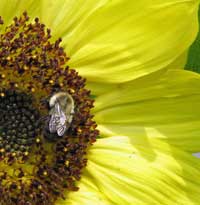 | | Great Bee Count |
|
How are native bees doing and what effect does their population have on pollination of garden plants, crops and wild plants?
You can help find out by participating in the Great Bee Count on July 16 anytime, but preferably 9 or 10 am. The more people who participate, the better we'll understand the native bee population.
Check The Great Sunflower Project website to learn how to participate. Click on Instructions and datasheet.
You can observe Lemon Gem sunflower (Helianthus annuus), beebalm (monarda), cosmos, rosemary, coreopsis (aka tickseed), or purple coneflower. Remember, if you see no bees, that's very important information to send in!
|
|
Onondaga Lakeshore Community Meeting
Tues. July 12, 6:30 at Solvay Library
| 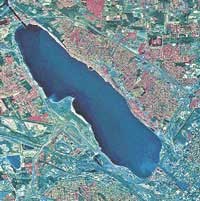 | |
This is your chance to hear about plans for restoring Onondaga Lake and to share your ideas about the restoration. The discussion will pick up from the Geddes Lakeshore Enhancement project currently underway along the lakeshore.
The Tuesday July 12 meeting will focus on native plants. Don Leopold will be there as a resource.
Solvay Public Library
615 Woods Rd., Solvay
|
|
Holistic Pest & Weed Management in Urban Gardens
Thurs. July 14,
5:30 - 7:30
|
 | | Unidentified, but abundant, weed. Please email me if you know its name. Thanks! |
|
In this FREE workshop gardeners will learn to create systems to combat weeds and pests. Bring your favorite garden tool and don't worry about getting dirty. (For more info) Stone Soup Community Education Garden 410-412 Gifford St. Syracuse, NY RSVP to Kayleigh phone 424-9485 x229 Sponsored by Cooperative Extension, NOFA-NY, and Syracuse Grows
|
|
Weed volunteers needed
Saturday, July 23, 8:00 a.m. ~ submitted by Fran Lawlor
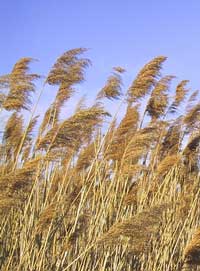 | |
Phragmites (Photo: michit - CC)
|
Elbridge Swamp is the largest preserve of the Central New York Land Trust (formerly Save the County). Carpenters Brook flows through this high quality, federally protected wetland. There is a small infestation of introduced Common Reed (European phragmites) in the western portion of the preserve, just at the edge of the federally designated wetland. It has expanded in two main patches, approximately a quarter acre each and in a couple of smaller patches.
The Land Trust is interested in non-chemical control of the phragmites to protect the water quality of the wetland complex. It has been shown that an annual cutting at the end of July will suppress common reed. Complete eradication using mechanical control is unlikely. The Land Trust wants to reduce the density of the common reed to encourage native plant species and associated wildlife. This is a once-a-year work project, for many years.
Bird species in the area: winter wren, great crested flycatcher, wood pewee, wood thrush, veery, pileated woodpecker, Baltimore oriole, and red eyed vireo. There are many black ash and tulip poplar along with some nice wetland plants.
To volunteer: Bring hedge clipper or hand pruners and wear long pants, long sleeves, work gloves and a sun hat (to keep away deer flies).
Saturday, July 23, 8:00 a.m. at the preserve. Contact Jeff Devine, CNY Land Trust, (315) 575-8839 .
|
| Interested in Edible Gardening? | 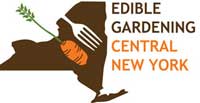
|
If you'd like to get information on Edible Gardening CNY, just send an email to John to find out about edible gardening tours and programs.
|
|
Join HGCNY!
|  |
Becoming an official member of HGCNY is easy: just join Wild Ones! When you're a Wild Ones member, you're automatically an official member of HGCNY. |
|
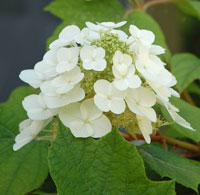 | Oakleaf hydrangea
(Hydrangea quercifolia) |
Greetings!
Time for Show Me, Help Me Tours
Summer is the time for our garden tours, which Wild Ones traditionally calls Show Me, Help Me tours. These aren't the kind of tours where you just admire beautiful gardens. These are tours where you learn from what the host has done and perhaps offer suggestions for any landscaping dilemmas they may have. Some of our tours have expert commentators, too. Our programs during the year are always interesting and informative, but there's nothing like seeing the results in people's yards!
PLEASE RSVP as soon as possible! Thanks!
Here are the dates:
Sunday July 17 at 3 pm in Canandaigua. This is a tour of a large woodland setting with trails and benches. This garden has been extensively developed in conjunction with White Oak Nursery's Jim Engel, who will co-guide the tour. It's a bit of a distance, but it promises to be worth the trip. We can arrange carpooling. RSVP to Linda with "Canandaigua tour" in the subject.
Saturday July 23: in Westvale at the Allens
- 9 am edible garden tour
- 10 am habitat garden tour.
Sunday July 24: in Westvale at the Allens
- 4 pm habitat garden tour
Tour either or both. Directions
Saturday July 30 at 2 pm in Fulton. This is a tour of a village lot backing up to a marsh. You can bring boots if you'd like to go into the marsh. Dan Carroll will co-guide the tour. RSVP to Linda, the host, with "Fulton Tour" as the subject.
Saturday August 27 in Jamesville - We will tour garden areas on a large rural property consisting of abandoned agricultural land and woods that have been harvested for timber over many years. RSVP to Randi, the host.
10:00 am: A long hike in the woods
11:30 am: A shorter garden tour near the house
Afterwards: You're invited to stay for a potluck picnic. Please bring your own table service, drink, chair, and a dish to pass.
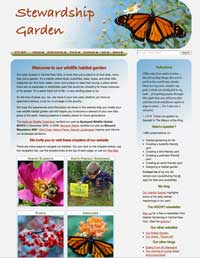 Meanwhile... Meanwhile...You can vicariously tour my own habitat garden by browsing through my website: OurHabitatGarden.org. You'll find lots of information about various creatures and how to provide habitat for them. Janet |
|
|
Guess the flower
This is a common native flower--but only part of it. What flower is it? (Answer below)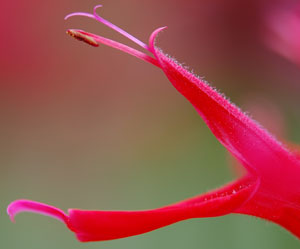
|
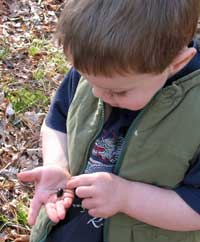 | | Examining a beetle |
Children need nature
The research of many child development experts has found many benefits for children when they have contact with nature. Dr. Stephen Kellert of Yale University: "Play in nature, particularly during the critical period of middle childhood, appears to be an especially important time for developing the capacities for creativity, problem-solving, and emotional and intellectual development." Dr. Hillary Burdette and Dr. Robert Whitaker: Their research finds that children will be smarter, better able to get along with others, healthier and happier when they have regular opportunities for free and unstructured play in the out-of-doors. Andrea Taylor, et. al.: Found contact with nature had a positive effect in reducing the impact of attention deficit disorder in children. Read more about these studies and others, especially many that focus on the important benefits derived from green schoolyards and schoolyard habitats. Summer Nature Camp: In addition to your habitat gardens, another way children can have contact with nature this summer is by attending Nature Camp at Baltimore Woods for ages 4 to 14, the critical years for reaping the benefits. |
|
How hummingbirds really drink
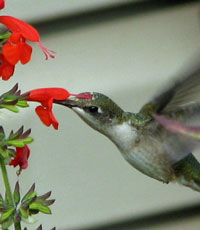 | | Hummer drinking |
Scientists used to think that tube-like channels in a hummingbird's tongue helped it suck up nectar by capillary action. The only problem with that explanation was that it didn't explain why the hummers preferred nectar twice as sweet as the physics of capillary action would predict.
Now, by using see-through flowers, scientists have found that the tubes in their tongue open down the sides when it hits nectar, then zips back up with the nectar inside.
See a video showing how a hummingbird's tongue gets nectar. The researchers say that understanding how this efficient tongue works may lead to breakthroughs in self-assembling electronics and the like. Or even more efficient mops or sponges! Next mystery they'll be studying: How does the hummingbird swallow the nectar? No one knows.
|
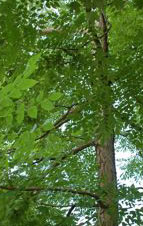 | | Kentucky coffee tree |
Thoughts on trees
One of the most consequential landscaping decisions you can make is your choice of trees.
Their impact--for good or ill depending on your choice--lasts for generations.
William Cullina, Native Trees, Shrubs & Vines: "One of the things you quickly learn about woody plants is the staggering number of birds, small mammals, insects, and fungi, not to mention people, that depend on them directly for their existence."
Sara Stein, Noah's Garden: Restoring the Ecology of Our Own Back Yards: "What one can't see on a woodland walk is that a great deal of that wood is underground. Plunging below the forest floor, sometimes as deep as the trees are tall, a dense network of roots excavates the soil to a spongy consistency that holds up to 90 percent of rainfall, letting the accumulated water trickle only gradually toward low-lying wetlands. By comparison, as much as 90 percent of the rain falling on a lawn is immediately lost as runoff, and with it the soil's mineral fertility."
Chinese Proverb: The best time to plant a tree was 20 years ago. The next best time is now.
Wild Ones Proverb: And make it native!
|
|
The mystery flower
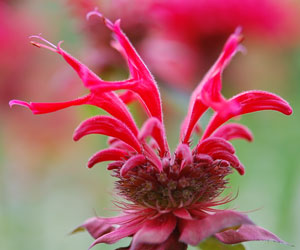 | | Oswego tea |
The mystery flower is Oswego tea (Monarda didyma). This member of the mint family is easy to grow, very showy, and provides nectar for butterflies, bees, and hummingbirds.
Nothing's perfect: it does spread some by runners, like many mints. This is wonderful if you want a large showy patch. Otherwise, just monitor it and pull up the ones you don't want. It's just too nice a plant to forgo! |
|
|
|
|